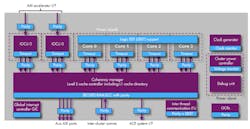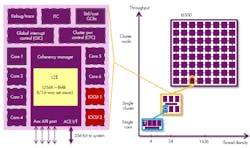Safety critical systems need to be built on silicon that has also been certified to meet safety critical standards. This means the design must follow strict guidelines in addition to incorporating hardware to catch errors that conventional designs would not.
Imagination Technologies’ MIPS I6500-F core (Fig. 1) targets safety critical applications such as self-driving cars, the Industrial Internet of Things (IIoT), and robotics. It is compliant with the ISO 26262 and IEC 61508 standards and designed to meet system-level ASIL D functional safety standards. The multicore architecture incorporates parity, timeout support, and built-in self-test (BIST) throughout.
The I6500 core uses simultaneous multi-threading (SMT) with a 9-stage, superscalar, dual-issue design and four threads per core. Instruction bonding combines sequential integer or floating point loads or stores into a single operation, doubling memory-intensive data move performance.
There is an optional dual-issue FPU/SIMD unit with 32 128-bit registers, with support for 8-/16-/32-/64-bit integer and fixed point plus IEEE-754 2008 compliant 16-/32-/64-bit floating point data. The core supports hardware virtualization (VZ) allowing “zero context switching” for real-time response. Scratchpad memory options allow the architecture to handle deterministic code execution, even with VZ and SMT support. Designs can incorporate up to 1 Mbyte of scratchpad RAM, plus up to 64 Kbytes of 4-way set associative L1 cache with ECC support.
Imagination’s OmniShield security architecture supports isolation of programs and peripherals. The virtualized global interrupt controller (GIC) allows OmniShield to provide interrupts with a controlled group of peripherals and applications.
The architecture is designed to work within Imagination’s cluster architecture (Fig. 2) that allows up to eight cores to be combined in a cluster node. Nodes can also incorporate I/O coherency units (IOCU). A cluster can have up to 64 nodes.
About the Author
William G. Wong
Senior Content Director - Electronic Design and Microwaves & RF
I am Editor of Electronic Design focusing on embedded, software, and systems. As Senior Content Director, I also manage Microwaves & RF and I work with a great team of editors to provide engineers, programmers, developers and technical managers with interesting and useful articles and videos on a regular basis. Check out our free newsletters to see the latest content.
You can send press releases for new products for possible coverage on the website. I am also interested in receiving contributed articles for publishing on our website. Use our template and send to me along with a signed release form.
Check out my blog, AltEmbedded on Electronic Design, as well as his latest articles on this site that are listed below.
You can visit my social media via these links:
- AltEmbedded on Electronic Design
- Bill Wong on Facebook
- @AltEmbedded on Twitter
- Bill Wong on LinkedIn
I earned a Bachelor of Electrical Engineering at the Georgia Institute of Technology and a Masters in Computer Science from Rutgers University. I still do a bit of programming using everything from C and C++ to Rust and Ada/SPARK. I do a bit of PHP programming for Drupal websites. I have posted a few Drupal modules.
I still get a hand on software and electronic hardware. Some of this can be found on our Kit Close-Up video series. You can also see me on many of our TechXchange Talk videos. I am interested in a range of projects from robotics to artificial intelligence.




